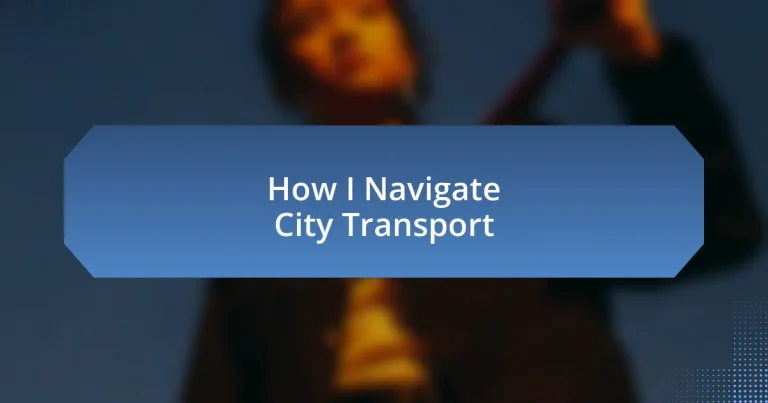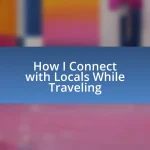Key takeaways:
- Navigating city transport systems involves understanding the unique culture and rhythm of the city, which can be discovered through exploration and getting lost.
- Choosing the right transport mode depends on factors such as distance, time, weather, cost, and the overall experience desired.
- Utilizing mobile apps for real-time updates and planning routes can significantly enhance the efficiency and enjoyment of city travel.
- Staying adaptable to alternative transport options and being aware of rush hour patterns can help avoid common pitfalls and improve overall travel experience.
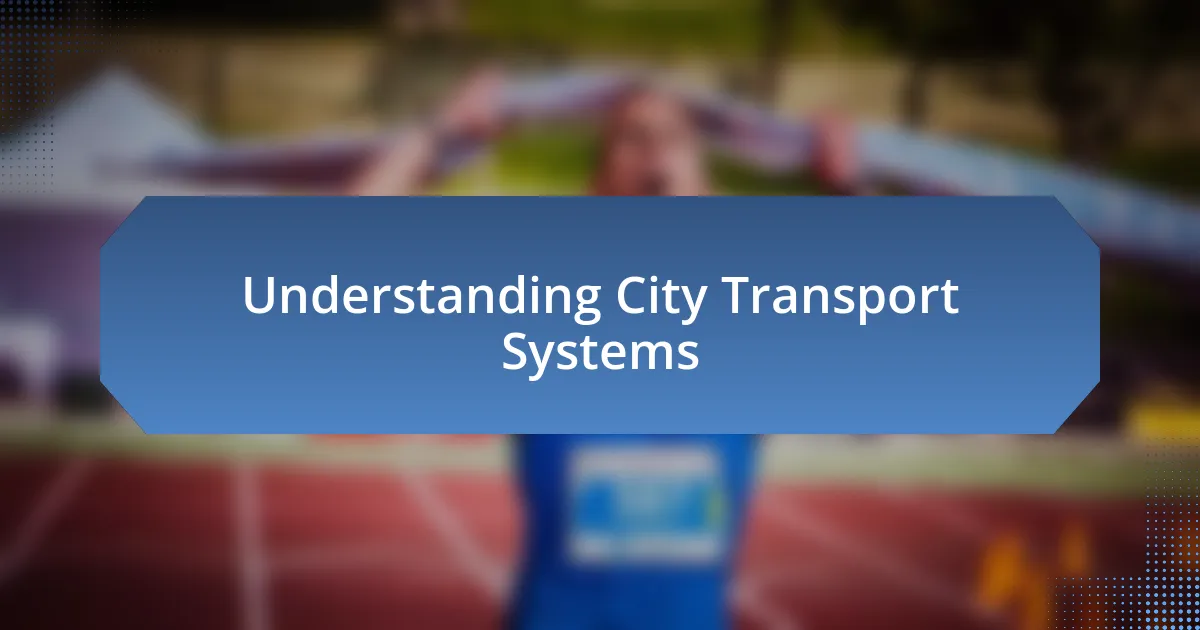
Understanding City Transport Systems
City transport systems can feel overwhelming at first, especially if you’re new to the area. I remember stepping off the bus in a bustling city, unsure of where to go next. The sheer volume of options – subways, trams, and buses – left me feeling both excited and anxious. How do you decide the best route amidst the chaos?
Navigating these systems often requires a bit of patience and exploration. For instance, I once spent an afternoon getting lost on purpose just to understand how different routes intertwined. That unplanned adventure not only familiarized me with the city but also revealed the hidden gems that locals cherish. Have you ever had a similar experience where getting lost turned into a discovery?
Moreover, learning about city transport goes beyond just the basics of getting from point A to point B. It’s about understanding the culture and rhythm of the city itself. Whether it’s the chatter on a crowded subway or the peaceful glide of a tram through quiet streets, each mode offers a glimpse into the daily life around you. When you think about it, isn’t that what makes navigating city transport truly special?

Choosing the Right Transport Mode
Choosing the right transport mode can often feel like solving a puzzle. Each option has its own unique benefits and drawbacks. For example, I once chose to bike across town on a sunny afternoon, only to realize how freeing it can be to feel the breeze while moving quickly through traffic. In contrast, on a rainy day, I opted for the subway, appreciating its reliability when the weather turned sour. This choice not only kept me dry but also enabled me to avoid traffic jams, which can be a significant time-suck.
When evaluating how to get around, consider these factors:
– Distance: Is your destination within walking or cycling distance?
– Time: How quickly do you need to arrive? Buses may stop often, while subways can offer faster transit.
– Weather: Is it sunny or rainy? The weather can dictate a more comfortable mode of transport.
– Cost: Is budget a concern? Public transport usually offers cheaper options than taxis or rideshares.
– Experience: What kind of journey do you want? Sometimes, the ride itself can be an adventure worth considering, like enjoying scenic views from a bus or tram.
By weighing these elements, you can make an informed choice that suits not just your practical needs but your mood and sense of adventure as well.
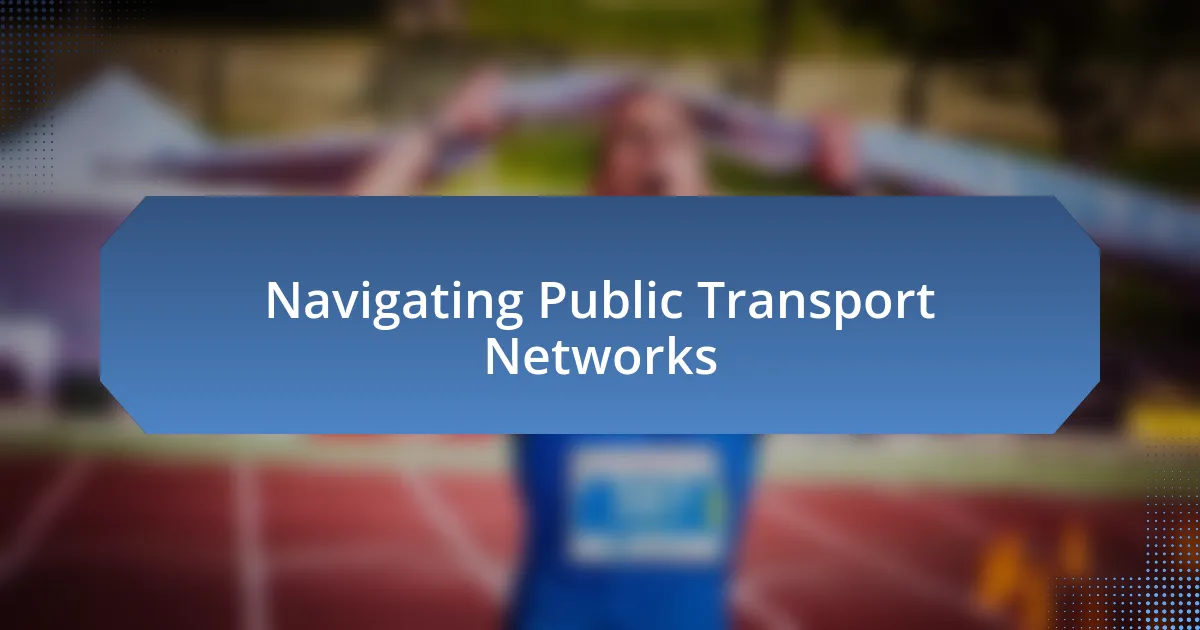
Navigating Public Transport Networks
Navigating public transport networks can be an adventure in itself. I remember the first time I used the bus system in a new city; it felt overwhelming, with all the routes and schedules. However, once I downloaded a transit app, I felt empowered. The app provided real-time updates and clear directions, turning what initially seemed daunting into a straightforward journey. Understanding the public transport map is key; I often highlight routes that pass by must-visit spots, making it easier to plan my day.
Another important aspect is timing. During rush hour, trains and buses can be packed, which reminded me of a particularly crowded subway ride where I had to squeeze in with a friendly stranger who ended up sharing some great local tips. Adjusting my travel time could sometimes mean opting for an early morning trip or waiting for lighter traffic in the evening. Timing can drastically change your experience on public transport.
Lastly, don’t shy away from asking for help. I’ve found that locals often appreciate the opportunity to share their knowledge. Once, while navigating an unfamiliar tram system, I asked a fellow passenger for advice. Their recommendations not only helped me reach my destination quickly but also introduced me to a charming café nearby—an unexpected treasure on my journey.
| Transport Mode | Advantages |
|---|---|
| Bus | Cost-effective and extensive coverage |
| Subway | Fast and avoids traffic |
| Tram | Scenic ride through neighborhoods |
| Biking | Flexible and allows exploration |

Utilizing Ride-Sharing Services
Ride-sharing services have revolutionized the way we navigate city transport, providing a convenient alternative to traditional taxis. I vividly recall a rainy evening when public transport seemed like a hassle; I opted for a ride-sharing app instead. Within minutes, I found myself snug in a warm car, chatting with the driver about the local hotspots. It was a simple choice that transformed my night.
One of the perks of using ride-sharing is the flexibility it offers. I often find myself needing a ride at odd hours, like after a late dinner or a spontaneous night out. The ability to request a ride at my convenience has made me feel more at ease exploring the city, knowing that help is just a few taps away. Have you ever experienced the relief of scanning a map and seeing your driver approach? It’s not just a ride; it’s a small moment of comfort in the chaos of urban life.
However, it’s essential to stay aware of the costs associated with ride-sharing. While it’s a fabulous option for late-night adventures, I’ve learned the hard way that surge pricing can hit unexpectedly. I remember a night where my funds dwindled as I tried to get home during peak surge hours—definitely a learning moment for budgeting my outings. Balancing convenience with cost is a dance I’ve gotten better at over time, and it adds a layer of strategy to my city navigation.
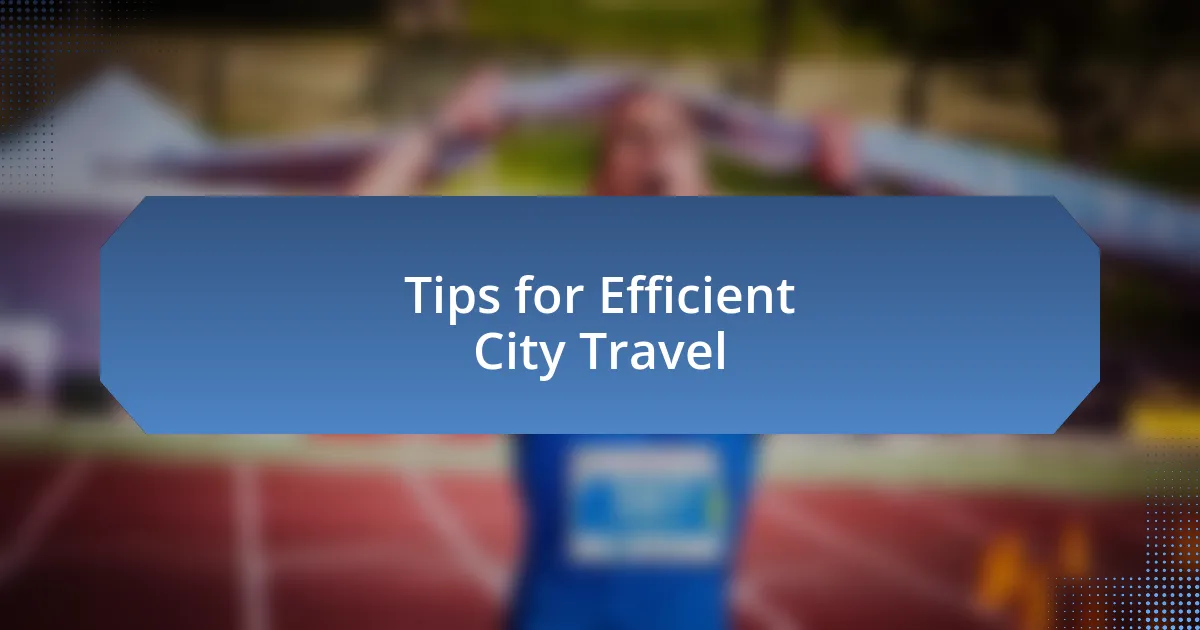
Tips for Efficient City Travel
Taking public transport can also enhance your efficiency while traversing city landscapes. I often find solace in the rhythm of the train as it glides through the urban sprawl, letting me read or plan the next part of my day. Have you ever caught yourself daydreaming or reflecting during a commute? That time can be invaluable, allowing you to mentally prepare for what’s ahead while avoiding the stress of traffic.
Additionally, planning my route ahead of time has proven to be a game changer. I remember a particularly busy Monday when I anticipated delays and chose an alternative route that saved me precious minutes. Knowing which lines or bus routes are less congested can steer you clear of unexpected stops and ensure a smoother journey. It’s amazing how a little preparation can turn frustration into a seamless adventure, isn’t it?
Lastly, I highly recommend understanding local travel apps and real-time updates. I’ve had moments where I was blissfully unaware of a service disruption, only to scramble for alternatives last minute. But when I started to rely on an app that provides live updates, it drastically changed my experience. Being informed not only reduces stress but allows you to feel more in control of your travel, making every outing an enjoyable exploration rather than a frantic race against the clock.
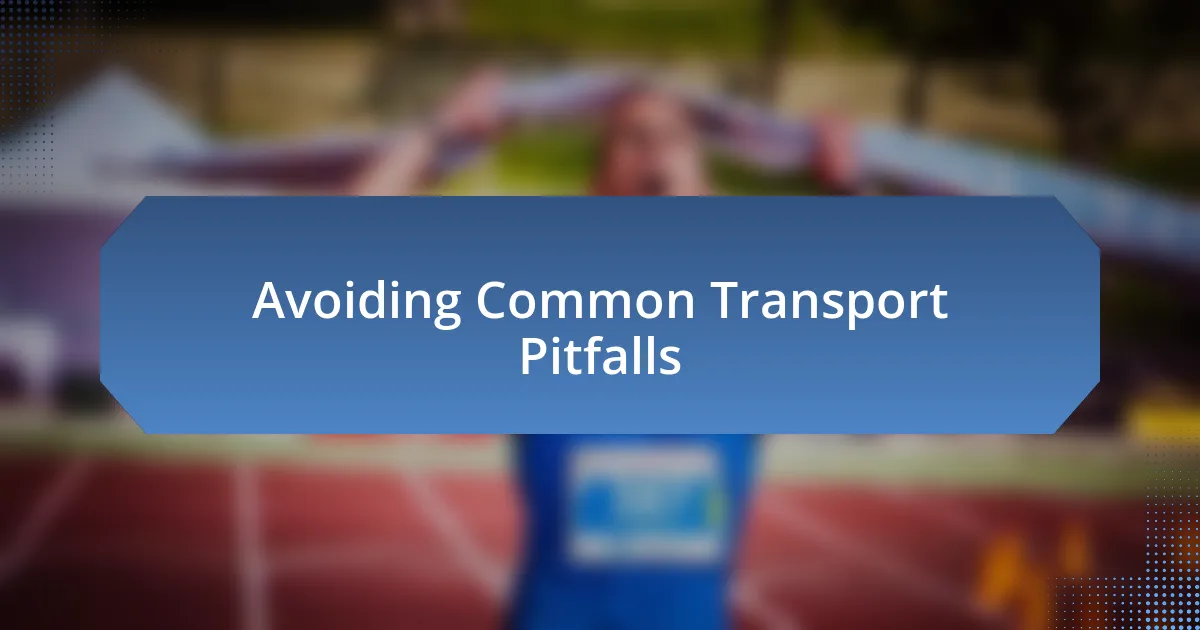
Avoiding Common Transport Pitfalls
Navigating city transport can sometimes feel overwhelming, especially when faced with unexpected delays or last-minute changes. I once found myself waiting at a bus stop, only to realize that I had misread the schedule and missed my bus by a hair. Since then, I’ve learned to double-check not just the timetable but also to confirm the right stop beforehand. Have you ever been caught off guard like that? Trust me, investing those extra few minutes to ensure you’re at the correct place can save you from a frustrating scramble.
Another common pitfall I’ve encountered is overlooking the importance of rush hour patterns. During my early city explorations, I naively thought I could hop on any train or bus whenever I pleased. However, I vividly recall a hair-pulling experience during a Friday evening commute, packed like sardines in a tin. Learning to adjust my travel times has made a world of difference; now I try to schedule my trips either earlier or later, allowing me to glide through the city without the chaotic hustle.
Furthermore, staying open to alternative transport options is crucial. I remember feeling hesitant about trying a bike-sharing service, thinking it would be intimidating. However, once I took the plunge, I found it liberating to zoom past traffic and soak in the city at my own pace. The key is to be adaptable and willing to explore new avenues; sometimes, the road less traveled leads to the most rewarding experiences. Have you ever thought about switching it up? You might discover something new about your city.
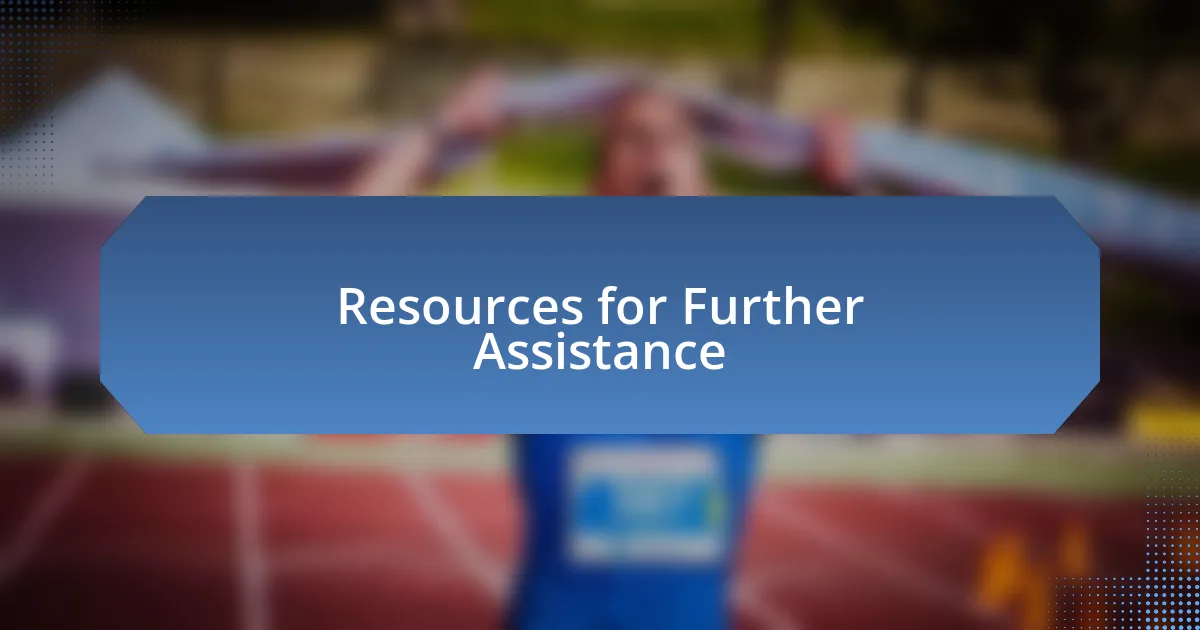
Resources for Further Assistance
When navigating city transport, having reliable resources can truly make a difference. One of my go-to tools is local mobile apps that provide real-time updates on transport schedules and delays. The last time I relied on one, I was able to reroute my journey on the fly, saving me from what would have been a frustrating wait at a crowded station. These apps often have user-friendly interfaces, making them accessible for anyone, even if you’re not tech-savvy.
I also recommend checking local transport websites for updates, especially for planned service changes or alerts. Early one morning, I missed an important announcement about a construction detour that delayed my favorite bus. It was a lesson learned—now, I make it a habit to glance at the site before heading out. A quick look can save you from unexpected delays and allow you to better plan your route.
Finally, don’t underestimate the value of community forums and social media groups where users share experiences and tips. I once came across a post from a fellow commuter about a secret shortcut during a festival weekend. That insight not only helped me navigate the situation better but also made me feel part of a supportive community. Have you ever found a gem of information in an unexpected place? Engaging in these online discussions can often lead to valuable insights that enhance your travel experience.
